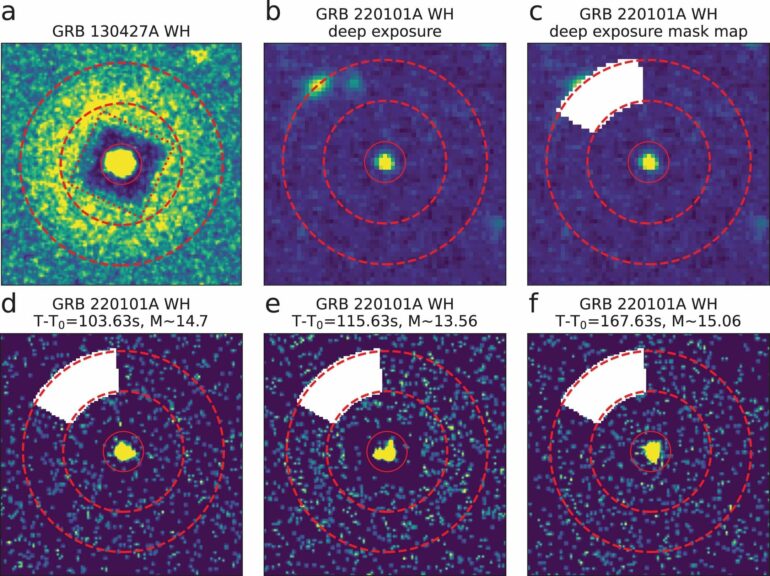Researchers from the Purple Mountain Observatory (PMO) of the Chinese Academy of Sciences and the Italian National Institute for Astrophysics have proposed a new method to measure moderately saturated sources of the Ultra-Violet Optical Telescope onboard the Swift satellite (Swift/UVOT), and identified GRB 220101A as the most energetic ultraviolet/optical flare ever detected. The study was published in Nature Astronomy on June 26.
Gamma-ray bursts (GRBs) are the most violent explosions in the universe. Their prompt radiation is mainly in the soft gamma-ray band and last briefly (i.e., from milliseconds to at most hours). The prompt emission is then followed by the X-ray, optical and radio afterglow emission, which lasts for weeks or even years.
The prompt optical emission of GRB 080319B set the universe-wide luminosity record for an ultraviolet/optical emission in 2008. It was so bright that an observer in a dark location could see it with the naked eye. The optical flare radiation from GRB 080319B traced the gamma-ray light curve and hence the activity of the central engine. But now, GRB 220101A has broken the earlier record.
On New Year’s Day 2022, the Swift satellite detected a new burst, GRB 220101A. The redshift of GRB 220101A was measured at 4.618. At such a high redshift, the observed optical photons were in the ultraviolet band and suffered from very serious absorption. Consequently, the intrinsic radiation flux was about 100 times higher than the observed value. Just 79 seconds after the burst, Swift/UVOT performed a quick 150-second observation in event mode in the white band.
The researchers then conducted high-time-resolution photometric analysis that revealed a rapid evolution of the flux. In particular, at the peak time the UVOT telescope was already moderately saturated.
“We proposed a processing method for UVOT data, based on the telescope’s point spread function, and verified that it indeed provides reliable flux measurements,” said Prof. Fan Yizhong from PMO, the corresponding author of the study. After the proper distance and absorption corrections, the absolute magnitude of the ultraviolet/optical emission of GRB 220101A reached -39.4, making it the only source to date with an absolute magnitude brighter than -39.
“It is also the first time to detect an extremely energetic ultraviolet/optical flare with a space telescope,” Prof. Fan added.
The luminosity of GRB 220101A is approximately 400 quadrillion times that of the sun, which breaks the 14-year record held by GRB 080319B. It also suggests a new astrophysical process, demonstrating the diversity of physical origins of super-bright optical-ultraviolet bursts.
The China–France Space Variable Objects Monitor (SVOM) satellite, scheduled to launch in early 2024, is expected to be able to detect extremely energetic ultraviolet/optical flares at even higher redshifts.
More information:
Zhi-Ping Jin et al, An optical–ultraviolet flare with absolute AB magnitude of −39.4 detected in GRB 220101A, Nature Astronomy (2023). DOI: 10.1038/s41550-023-02005-w
Provided by
Chinese Academy of Sciences
Citation:
Scientists use new method to measure most energetic ultraviolet/optical flare ever detected (2023, June 29)



